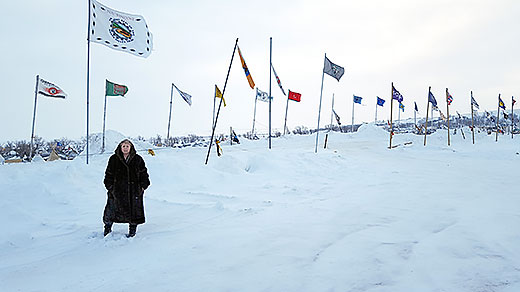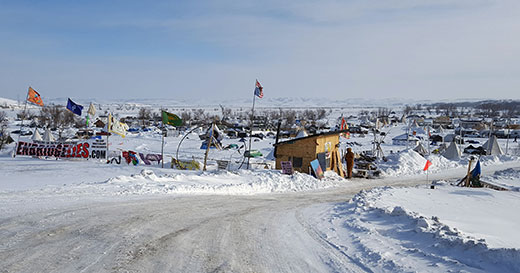BY ELIIDA LAKOTA
Editor’s note: Donald Trump may try to overturn the U.S. Army Corps of Engineers’ decision to halt the Dakota Access Pipeline, and Native American Tribal Leaders may demand protesters leave the Standing Rock encampment before spring flooding, but the world has watched and learned about injustice in America. A New Yorker magazine article said the project is like proposing construction of a pipeline under Jerusalem. Another New Yorker article said the world saw Standing Rock as a template for resistance.
Central Illinois residents have joined people from throughout the country traveling to North Dakota to stand against the Dakota Access Pipeline proposed to cross sacred Indian grounds and under the Missouri River. Here is a first-person account by one local Native American woman who went to Standing Rock in early January to pray and support the “water protectors.”

Eliida Lakota stands before flags of more than 90 Native Nations flying in defiance of the Dakota Access Pipeline route across Indian lands and under the Missouri River. Lakota traveled to Standing Rock Sioux Reservation in North Dakota to pray with the protesters, to learn and to assist with operation of the encampment. Despite a wind chill of 45 below zero, about 500 campers remain, including veterans from around the country.
We arrived at the Standing Rock Casino Hotel Jan. 4 and met our guide who would explain to us what we would be seeing and doing the following day. We were a group of nine people from a church in the Peoria area. It was the church of my friends who were kind enough to permit me to go with them. Our guide was not Native American but was married to a Lakota woman. The goals of the group were to pray for the project and for the people there, and to better understand what was going on there.
The goals of the Native Americans and the campers at the protest encampment were twofold. For the Native Americans one goal was to object to the government’s disregard for treaties, Indian land and Indian rights. The ownership of the encampment land is disputed; the government says it’s government land and some Indians say it is treaty land. Treaty land is land that was promised to Native Americans in a treaty but never turned over to them.
Historical betrayals of Indian land
There are numerous excuses for why the land has not been turned over to Native people. One is land could be withheld if a person could not prove that they were able to maintain it. I heard of one couple that had been farming their allotted land until they were notified they no longer owned their land. The government did not believe they could maintain the land, so they lost their vegetable and herb garden.
Many problems with Indian land can be traced to the Dawes Act of 1887 that divided Indian land into 160-acre parcels. It was an effort to force Native Americans to give up tribal government, communal land and justice and assimilate into white society. Use of the parcels was restrictive and many owners were forced to sell all or part of their allocation. Indian lands were reduced by 100 million acres under the Dawes Act.
Allegations of government mismanagement of Indian trust funds were the basis for the Cobell class-action lawsuit against the U.S. Department of the Interior and the Department of the Treasury. The case, one of the largest class actions against the U.S. government, was settled in 2009 for $3.4 billion with $1.4 billion going to plaintiffs (estimated at between 250,000 and 500,000) and $1.4 billion allocated to restore land fractionalized by the Dawes Act.
The United States has broken many, many treaties with Native Americans, and these are real important issues. Native Americans want these treaties honored.
There are already two pipelines running through this region. For many of us, the real issue is why are we building more invasive pipelines at a time when we need to develop alternative energy sources. The oil in question is not U.S. oil, and it is not destined for U.S. consumers.
Protest encampment
In addition to debate over land ownership, the camp is in a flood plain. Last year in the autumn, there were 2,000 people at the encampment. When I arrived Jan. 4, the number had dropped to about 500. Protesters, who prefer to be called “water protectors,” plan to remain at the Standing Rock Sioux Reservation until the pipeline is diverted. Pipeline owners Energy Transfer Partners and Sunoco Logistics contend they will not alter the route.
We knew it would be quiet when we arrived at camp. The wind chill was 45-degrees below zero. The sun was deceivingly bright, pretending to be warm. I think my cheeks froze in about five minutes. Snow drifts were 6- to 8-feet high in spots.

A banner “Enbridge Lies.com” is posted at the entrance to the encampment at Standing Rock where hundreds of protesters are staying in yerts, tepees, tents, campers and sheds despite 45 degree below zero wind chills. Enbridge is one of the partners in the pipeline project that crosses Indian lands and under the Missouri River.
The encampment village is made up of hundreds of tepees, all kinds of camping tents and at least 50 yerts. There were lots of small temporary wood structures and solar panels. There were two meal tents, a prayer yert and two very large chemical toilet yerts. Meetings are held in one giant yert.
At a general meeting that afternoon, we learned there was a shortage of volunteers for cleaning and maintaining the chemical toilets.
Since pipeline work was on hold, protesters were busy building and repairing shelters, preparing food, visiting with neighbors and attending prayer meetings.
People were there from all over the country to support the cause. Just arriving were 20 yerts sent from Mongolia. Some people had been at the encampment for months and some for weeks.
My goal was to pray for the success of people at the encampment and learn more about the work. I helped with construction and maintaining chemical toilets.
The official Standing Rock reservation is south of Cannonball River and the protest encampment was on the north of the Cannonball on disputed land claimed by both government and Native Americans. A bridge crossing the river was blocked by burned-out cars, an attempt to keep police from crossing to the encampment and using rubber bullets, small exploding devices and tear gas. On the ridge above the camp, dozens of giant spotlights were directed to aggravate the campers. Instead of aggravation, the lights created a dusky moonlight effect.
All in all, the diversity of support was wonderful to see. People were there from all over the world, from many different religions and races, coming together for common cause. Clean water. Respect for all people. Protection of the environment from corporate greed. I saw something at the camp that was more than protest and more than common cause. I saw brotherly love and a glimpse of a “one world” ethos.

1 comment for “Standing Rock: Template for resistance”
Recent Comments